Notre-Dame-La-Grande
Dr. Marie-France Hilgar
Notre-Dame-La-Grande in Poitiers is a magnificent building which deserves our admiration just as much today as when it was built over 1,000 years ago. The church is first mentioned in the year 924, though we are not sure of the exact time of its construction. Recent excavations have shown that the church was erected on the site of a pagan temple, and in 1499 the priests of Notre-Dame-La-Grande did not hesitate to affirm that the "notable church was founded by Charlemagne in honor of Our Lady in the center of the city of Poitiers" but there is no proof in support of this claim. Nevertheless, the church finds mention in several cartularies, or registers: that of Redon in 924 (ad ecclesiam beata Virginis Marie), that of the Saint Cyprian abbey in 965 (ex canonica beate Marie), that of Saint Maixent around 987-1011 (Sancta Maria vocabulo Grande), finally referred to in 1087 as Santa Maria Major. It was located in the busiest part of the city, especially on Saturday, market day. It was also close to the palace of the dukes or counts. The first known pastor was Fr. Lannon, mentioned as early as 938, who was also archdeacon at the nearby Cathedral. By 1247, sixteen priests were assigned to Notre-Dame-La-Grande.
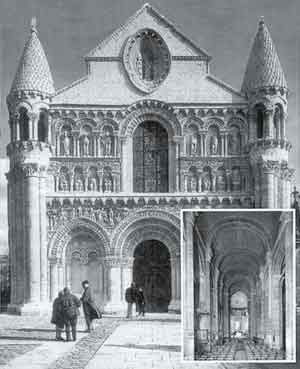
The statue of Our Lady of the Keys, found nowadays in the back of the sanctuary, symbolizes or justifies the close relationship between the church and the city. According to historian Jean Bouchet (1476-1557), in the year 1202 (we can excuse the inaccuracy of this date) a clerk employed in the service of the mayor of Poitiers promised the English to open the city gates to them during the night before Easter. When the time came, the clerk went in search of the keys, which the mayor placed every night at the foot of his bed. A bit disappointed in not finding the keys, he waited until 4:OO a.m. to ask the mayor for them. The mayor could not find them either. "Suspecting treason, he immediately ordered armed men to go to the gates of the city while he went to Notre-Dame in order to place the city under God's protection." To his surprise, he found the keys he had been looking for in the arms of the statue of "good Virgin Mary." At the same time, frightened by the sudden apparitions of the Virgin, St. Hilary and St. Radegonde above the rampart gate which the treacherous clerk had promised to unlock at midnight, some 1500 English men turned their swords against each other under the walls of the city.
The modern age, fearing to be called credulous, dismisses the story as a legend. But for several centuries votive candles burned night and day on a wheel placed over the statue of Our Lady, and many doors and monuments in Poitiers are adorned with statues representing the three interceding saints. Then in the 15th century and afterwards, each year on Easter Sunday after Vespers the mayor's wife, accompanied by the wives of the city officials, offered to the Lady of the Keys a mantle worth at least 300 pounds. The following day the mayor and one of his assistants took the statue all around the ramparts in solemn procession, in which the priests and parishioners of the neighboring churches also participated. The procession was recorded as taking place there as early as 1428 and every year thereafter until 1794, then from 1816 to 1829. It was re-established in 1850 and lasted until 1887.
The largest portion of the church seems to have been built in the 11th century. There used to be a cloister, but it was destroyed in 1859. In the 15thand the beginning of the 16thcentury, ten notable families had side chapels built in order to be buried in them. But soon the wars of religion prevented adding to the construction. In 1541 "wicked men cut off the arms of the image of Our Lady" which was at the entrance of the church. On May 27, 1562, eleven companies of Gascony under the orders of the sires de Grammont and de Duras pillaged all of the churches in Poitiers. They broke, among other things, the statue of Constantine which adorned the South door of our church. They also burned the miraculous statue of Our Lady of the Keys (a new one was sculpted the following century). The church was devastated.
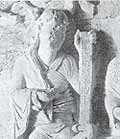 |
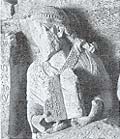 |
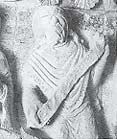 |
|
The Prophets Daniel, Jeremias, Moses.
|
||
During the 17th and 18th centuries, it took the generosity of a small number of priests and parishioners to restore the church. The chapter records registered the acquisition of a new main altar (1644), several tabernacles (1647), confessionals (1646, 1647, 1761), restoration of the stalls (1600), the bells (1622), the side chapels (1642), the "image of Our Lady" (1644), donations of paintings (1638,1642), of tapestries (1655), etc.
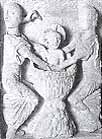 |
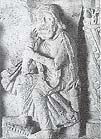 |
 |
The Child Jesus being bathed, St. Joseph,
and the Reconciliation of the Old and New Testaments
Then came the French Revolution. The law of February 11, 1791, closed down 18 of the 24 churches of Poitiers. Notre-Dame escaped but was renamed "the Republic" and was used for wood storage in 1794. The following year it was restored to its sacred usage, but the cloister, considered as government property, was sold off.
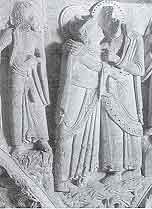
The Visitation
When the famous writer Prosper Merimée was named general inspector of Historical Monuments in 1834, he came to inspect Notre-Dame-La-Grande. His limited budget did not allow him to proceed with repairs. Then, in 1839, he received an alarming report. The timber framework under the roof was overhanging by sixteen centimeters, and demanded immediate attention from the administration, who put Notre-Dame-La-Grande on its top priority list. From 1845 to 1850, the timbering of the roof was completely replaced, the South wall repaired and some work was done to the sculptures of the façade. However, the latter kept deteriorating. In 1974 research laboratories identified, stone by stone, what types of limestone was used for the different parts of the building. They also discovered the principal causes of the different alterations, among which were cited alveolisation, disaggregation, erosion, pollution and also abnormal quantities of salt which transformed the limestone into gypsum.
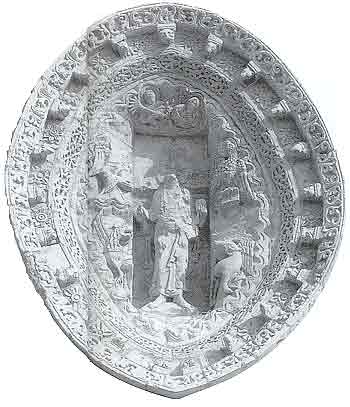
Mandorla containing Jesus Christ, Sun, Moon and Tetramorph
Considerable and spectacular work was undertaken from 1992 to 1995, the result of which is truly splendid. Merimee called the façade a magnificent bas-relief. It is composed of three registers: the lower one consists mainly of the entrance door, the median register has in its center a large stained glass window flanked by two rows of arches, the lower one resting on five simple columns and the higher one on twin columns in the center and simple ones at the end. In the center of the higher register is a mandorla containing Jesus Christ, the Sun, the Moon and the Tetramorph. The two circular towers on each side, topped by steeples in the form of cones, give to the building a vertical outlook and a wonderful balance. The decoration gives an animated look to the architectural composition. It was conceived not only to enhance its aesthetic quality, but also to proclaim to the world the essential message of Catholicism. Jesus, Son of God, became man to save humanity. This is the message of the frieze that crowns the first register, from left to right in three parts: original sin, the promise of redemption, the coming of the Redeemer. All the way to the left are Adam and Eve naked under the tree with the snake that enticed them into eating the forbidden fruit. Then come five people who announced the coming of the Savior, the first being Nabuchodonosor who, though a pagan, recognized the supremacy of the God of Israel. Then come four prophets: Daniel, Jeremias, Isaac and Moses. They are followed by the Archangel Gabriel telling the Virgin Mary she will give birth to the Messiah. Jesse, the ancestor of Jesus is recognizable by the tree forthcoming from his head and topped with the dove of the Holy Ghost, as well as David, sitting, with a harp, which unfortunately was broken off in the 16th century. On the other side of the door we find the end of the story of the Incarnation. Elizabeth accompanies her exclamation and "blessed is the fruit of thy womb," by pointing towards the Child whom the expectant mother is carrying. The encounter takes place in the presence of two women. The one on the left is busy spinning. She is in front of two buildings which may represent the Synagogue and the Church, the Old and New Covenant. Then comes a down-to-earth Nativity scene with the newborn Child wrapped in swaddling clothes in His crib, which is made warm by the breath of the donkey and the ox. To the left of the scene, two women bathe the Child, Whose head glows with a cruciferous halo. To the right, Joseph is sitting, thinking, his chin in his hand. Underneath him, two men embrace each other, representing the alliance of the Old and the New Covenant. Under the mandorla in the smaller arches are the twelve Apostles, either standing or sifting, all with halos, the only recognizable one being Peter, who holds the keys in his left hand. Then come two haloed bishops, probably St. Hilary, the most famous of Poitiers' bishops for having successfully fought against Arianism, and his disciple Martin, founder of the first monastery in Gaul, Liguge, and future bishop of Tours.
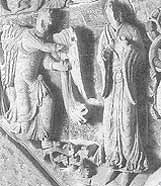 |
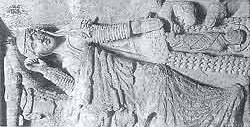 |
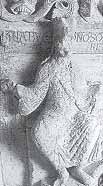 |
|
Archangel Gabriel and the Virgin of the Annunciation
|
The Nativity
|
Nabuchodonosor
|
One could spend hours looking at all the details of the sculpted decoration dating back to the 1130's, and maybe earlier. We can only imagine how it looked when it was full of vivid colors. The recent restorations confirmed that the ground under Adam's and Eve's feet was red, the cloak of the archangel was blue, that of the Virgin green, etc. The polychrome was maintained for a long time. In November 1483, a document attested to a certain sum of money, which was paid to "clean the images which are over the great door of the Church." In 1562 a good number of statues suffered decapitation at the hands of the Huguenots.
Upon entering into the church one may be surprised by the rather small size of Notre-Dame called "La Grande." The epithet was probably given to distinguish it from the other four churches dedicated to Our Lady in Poitiers. Perhaps they also desired to establish a correlation between the church in Poitiers and the famous Roman basilica of St. Mary Major. The beauty, at least in our estimation, of French Southern churches is that, with the exception of St. Servin in Toulouse, they offer a painted decoration. Some of it was restored rather recently (1851) and as usual was immediately described either as awful (writer Huysmans) or wonderful (sculptor Rodin). The colors are quite close to those used in the 12th century, as seen in the fresco of that period, which stands above the sanctuary, and which was discovered in 1852. It is in rather poor shape, but in the center, we can still easily distinguish the Virgin holding the Child Jesus in her lap in a mandorla between two angels and six lady saints. In a rectangle placed a little more to the west sits a large Christ in a double mandorla, surrounded by two angels, the four symbols of the Evangelists and the figures of the Sun and the Moon. Further yet the Lamb is placed in the center of a medallion borne by four angels and on the sides of the vault are the twelve Apostles, while angels lead the Blessed to the heavenly Jerusalem.
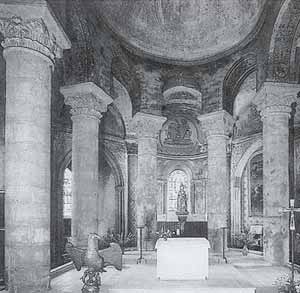 |
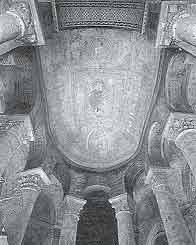 |
|
The sanctuary and its vault, containing frescoes dating from the 12th century.
|
|
On the right side of the ambulatory is the chapel built by Yvon du Fou in 1475. An anonymous work of great quality, a deposition scene of Our Lord, was placed in the chapel in 1802. Joseph of Arimathea and Nicodemus are laying Him in the tomb in the presence of the Virgin and St. John in the center, both cut from a single stone which gives the date of sculpting: 1555. Two holy women are present. On the left side of the ambulatory a small door leads to a very small crypt. Its frescoes, discovered in 1945, date from the beginning of the 12th century. On the vault was a Christ in majesty and the divine Lamb surrounded by the symbols of the Evangelists. On the walls are painted four saints holding either a crown or a book. The inner chapel was totally redone in the middle of the 19th century. Its stained glass window was offered by Msgr. Pie, the then Bishop of Poitiers. The window represents him kneeling in front of the Virgin of the Keys. He is identified by his episcopal motto: Tuus sum ego from Psalm 118. He has laid down his miter and his staff as proof of his submission. The Chapelle du Chapitre offers a very baroque monument carved out of polychrome stone dedicated to the theme of a good death. An angel, his finger pointing towards heaven, appears to a dying man.
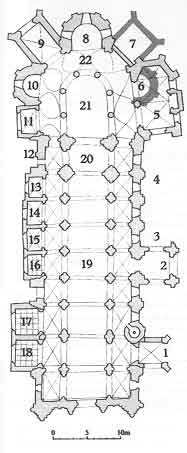 |
1.15th-century Porch 2. Porch 3. Chapel of St. Blaise 4. Sacristy 5. Chapel du Fou 6. South apse (destroyed) 7. Chapel du Crucifix (destroyed) 8. Chapel d'Axe 9. Chapel de Torsay 10. Chapel du Chapitre 11. Chapel Fumé
|
12. Pre-Roman wall 13. Chapel Gillier 14. Chapel Amboise 15. Chapel Bardeau 16. Chapel Citoys 17. Chapel Fresneau 18. Chapel Potier 19. Name 20. Bay beneath the bell tower 21. Chancel 22. Ambulatory |
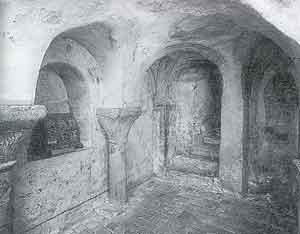 |
 |
 |
Crypt chapel with 12th-century frescoes representing four unidentified saints.
In the next chapel, which was built in 1427 by Jean de Torsay, is found a beautiful neo-Romanesque altar which used to be the main altar in the sanctuary. It represents, from left to right and on each side of the Virgin with the Child, four saints from Poitiers: Hilary, Radegonde, Macrina and Fortunatus. Its tabernacle and gradine are made of bronze and engraved with enameling.
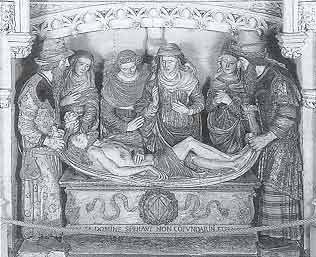
Deposition (1555) with Joseph of Arimathea, St. John, the Virgin Mary,
Nicodemus, and two holy women.
One of the side chapels, built at the end of the 15th century by the Gillier family, was totally redone in 1909 when Joan of Arc was beatified. The stained-glass window represents Joan being interrogated in Poitiers in 1429. Through a window can be seen, supposedly, Notre-Dame-La-Grande. There is also a painting of St. Sebastian being cared for by St. Irene. Another small side chapel, that of the Bardeau family, has a stained-glass window depicting Englishmen slaying each other. The Citoys family built the next chapel, which is decorated with a 16th-century stained-glass window depicting the seven virtues, and a painting which represents St. Paul on his way to Damascus, thrown down from his horse. The virtues are recognizable by their attributes: Justice with its scales, Faith with its book, Charity with its children, Fortitude with a dagger, and Prudence with a mirror.
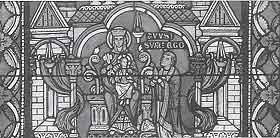 Detail of stained-glass window showing Bishop Pie, the future Cardinal Louis-Edouard-Desire Pie of Poitiers (1815-1880) at the foot of the Virgin of the Keep. |
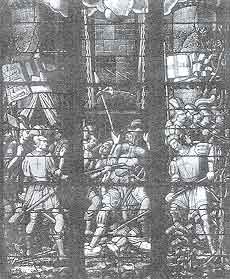 Chapel Bordeau, Englishmen fighting each other. |
 Chapel Gillier, Interrogation of Joan of Arc. |
|
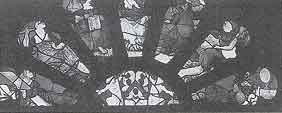 Chapel Citoys, TheVirtues. |
There are many more items worthy of our admiration: the lavish decoration invites the visitor to meditate upon the message of peace and hope which inspired its composition.
Dr. Marie-France Hilgar is a native of France, mother of four children, and assists at the Latin Mass at Our Lady of Victory Church, Las Vegas, NV. She is Distinguished Professor of French at the University of Nevada, Las Vegas and International President of the Foreign Language Honor Society. She specializes in 17th-century history and has authored several books and more than 100 articles.
